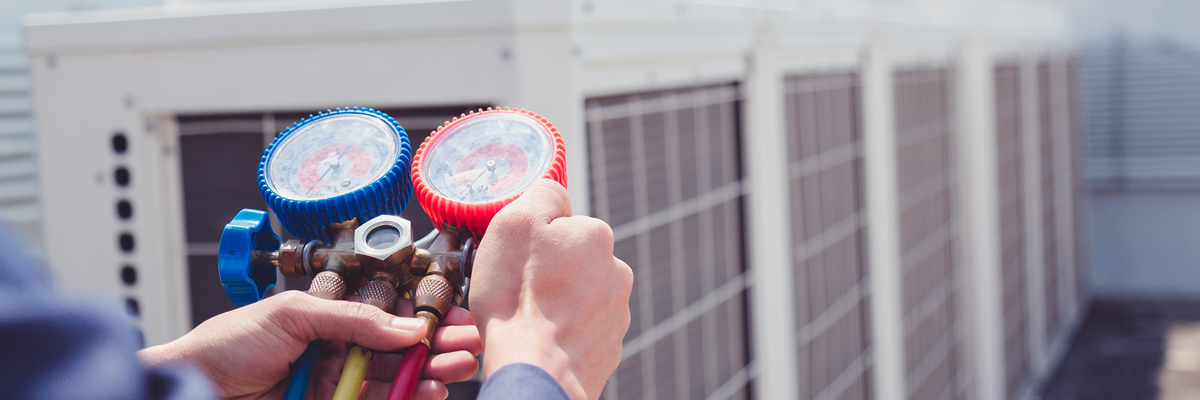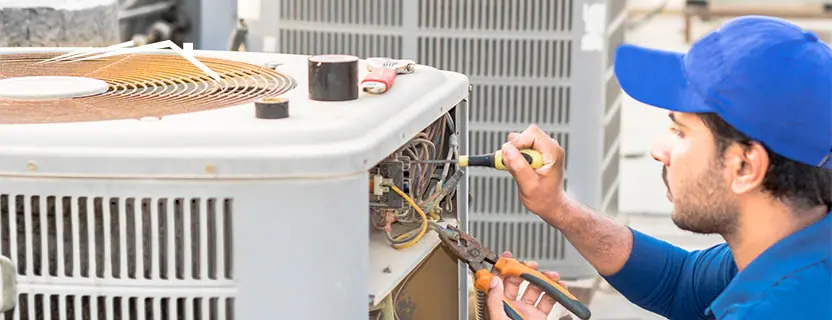Just How a Heatpump and Furnace Interact to Optimize Your Home's Heating Efficiency
Comprehending exactly how a heatpump and heating system interact is important for homeowners looking for efficient home heating services. Each system has its toughness, offering a well balanced technique to home comfort. The heatpump masters modest temperatures, while the heating system delivers fast heat during extreme cold. This harmony not only reduces power expenses but also improves the life-span of both appliances. What aspects affect this partnership, and just how can property owners optimize their advantages?
Understanding Warm Pumps: How They Work
Lots of individuals may be unknown with their internal operations, heat pumps play a vital duty in modern heating systems. These gadgets run by moving warmth from one area to another, utilizing the principles of thermodynamics. In cooler months, a heat pump extracts heat from the outside air, ground, or water, and transfers it inside your home to heat the living room. Conversely, during warmer months, it can reverse the process, serving as an a/c by eliminating heat from inside to the outside.Heat pumps consist of an evaporator, compressor, condenser, and expansion shutoff. The cooling agent within the system absorbs heat as it evaporates at reduced temperature levels and pressures. The compressor then enhances the pressure and temperature of the cooling agent, permitting it to launch warm as it condenses. This effective process can significantly decrease energy intake contrasted to standard heating techniques, making heatpump a sustainable choice for environment control in homes.
The Duty of Heaters in Home Home Heating
Furnaces play a vital function in home heating by offering a reputable source of warmth throughout the chillier months. They run by producing warm through burning or electrical resistance, dispersing it throughout the home by means of ducts or glowing systems. The performance of a heating system is usually gauged by its Yearly Fuel Application Performance (AFUE) score, which indicates just how efficiently the unit transforms fuel right into heat.Furnaces can utilize numerous power resources, including gas, power, propane, or oil, enabling property owners to pick the most ideal option for their demands. Unlike heat pumps, which might struggle in extreme cool, furnaces preserve consistent performance, ensuring that indoor temperature levels remain comfortable no matter of outdoor conditions. In addition, modern heating systems often come furnished with innovative technology, such as clever thermostats and variable-speed blowers, improving their performance and responsiveness. This adaptability makes heaters a vital part in all-encompassing home heating techniques.

Advantages of Making Use Of Both Equipments With Each Other
Combining the strengths of both heaters and heatpump can bring about an extra reliable and efficient home heating solution. Using both systems allows homeowners to make the most of the warmth pump's power effectiveness during milder temperature levels while relying upon the heater for more severe cold conditions. This twin technique can significantly lower energy prices, as warm pumps eat less electricity than standard heating methods when temperature levels are moderate.Additionally, making use of both systems together can boost comfort degrees in the home. Heatpump can give constant, even home heating, while furnaces can swiftly elevate ambient temperatures when required. Additionally, the assimilation of both systems can extend the life-span of tools by decreasing deterioration on each unit, as they share the workload. Ultimately, home owners can enjoy a balanced, cost-efficient heating service that changes flawlessly to varying climate condition, ensuring a cozy and welcoming home throughout the winter season months.
Just How Heat Pumps and Furnaces Complement Each Various Other
When homeowners integrate heatpump and heating systems, they develop a corresponding heating unit that takes full advantage of performance and comfort. Heatpump run by moving warm from the outdoors air or ground, making them highly efficient in modest environments. They succeed throughout milder temperature levels, giving cost-effective home heating. Conversely, furnaces create warmth via burning or electric resistance, delivering solid, prompt heat during extreme cold conditions.The mix of these 2 systems enables for dynamic adjustments based upon temperature level variations. Throughout warmer months or milder wintertime days, the warm pump can take the lead, saving energy and reducing prices. As temperature levels decline, the heater can flawlessly involve, making sure regular heat throughout the home. This harmony not only optimizes energy use yet likewise improves the lifespan of both systems, as each device runs within its suitable performance range. With each other, they create a well balanced atmosphere that adapts to differing climate needs.
Maximizing Effectiveness: Tips for Homeowners
Property owners can boost their home heating effectiveness through a number of useful techniques. Developing a regular upkeep routine, incorporating wise thermostat modern technology, and applying efficient insulation and securing services are vital steps. These actions not only enhance convenience but likewise reduce power prices.
Routine Upkeep Schedule
To ensure optimal heating effectiveness, developing a regular maintenance timetable is important for any kind of home. Homeowners ought to focus on regular evaluations of both heatpump and furnaces to establish peak performance. This includes transforming air filters every one to 3 months, as blocked filters can substantially reduce effectiveness. Additionally, scheduling expert upkeep at the very least yearly enables professionals to identify and deal with prospective problems prior to they intensify. Home owners should also clean the heatpump's outside system to stop particles build-up that can hinder airflow. By adhering to a routine maintenance routine, house owners not just boost their home heating systems' performance yet additionally expand their life-span, bring about greater convenience and reduced energy costs throughout the colder months.
Smart Thermostat Integration
Integrating a clever thermostat into a home heater can substantially boost energy efficiency, specifically as it enables accurate control over temperature setups. These gadgets can learn the home owner's routine and preferences, instantly changing the temperature level to optimize convenience while lessening energy usage. They can decrease heating throughout times when the home is vacant, reducing unnecessary intake. Lots of clever thermostats likewise provide real-time energy use data, making it possible for property owners to make informed choices concerning their heating behaviors. Additionally, remote accessibility through smart device apps enables customers to adjust settings from anywhere, making certain the home is warm upon return. Generally, clever thermostat integration not just boosts comfort however substantially contributes to energy cost savings and effectiveness.
Insulation and Securing Solutions
Smart thermostats play an important duty in energy efficiency, however their efficiency can be greatly improved by correct insulation and sealing services. House owners should prioritize protecting attics, wall surfaces, and floorings to decrease heat loss. Premium insulation products, such as spray foam or fiberglass, can considerably boost thermal resistance. In addition, securing voids around home windows, air ducts, and doors avoids chilly air infiltration and heat escape. Weatherstripping and caulking are effective methods for dealing with these leaks - heat pump service. Regular evaluations for air leaks, along with the usage of blower door examinations, can assist determine issue areas. By spending in insulation and securing, property owners can optimize the performance of their heating unit, eventually causing minimized energy consumption and reduced energy bills
Typical Misconceptions Regarding Heat Pumps and Furnaces
What misconceptions border warmth pumps and furnaces? Numerous individuals wrongly believe that warmth pumps are inadequate in cooler climates. In truth, modern-day heatpump are designed to run effectively even in reduced temperatures, providing reliable home heating throughout wintertime. Another usual myth is that heaters are always more effective than heatpump. This depends on the details energy resources and efficiency rankings of the units in inquiry. Some may likewise think that utilizing both systems at the same time is unneeded, but in reality, this combination can enhance home heating efficiency, especially throughout severe climate condition. Additionally, people commonly presume that heatpump need constant maintenance, when actually, they have comparable maintenance needs to conventional heater. By exposing these misconceptions, property owners can make even more enlightened choices regarding their heating alternatives, inevitably resulting in enhanced convenience and energy effectiveness in their homes.
Upkeep Considerations for Combined Systems

Often Asked Inquiries
Can Heat Pumps Job Properly in Incredibly Cold Climates?
Warmth pumps can have a hard time in exceptionally cold climates as a result of lowered efficiency and warm removal constraints. Developments in innovation have led to designs created for much better efficiency in such problems, improving their feasibility in extreme settings.
The Length Of Time Do Warm Pumps and Furnaces Commonly Last?
Heat pumps typically last 15 to 20 years, while heating systems have a lifespan of 15 to 30 years. Regular upkeep can expand their long life, making certain efficient procedure and minimizing the demand for early substitutes.

What Is the Typical Expense of Putting Up Both Systems?
The typical expense of mounting both a heatpump and a furnace commonly varies between $5,000 to $10,000 - heat pump replacement ooltewah tn. Elements affecting this price include system size, installment intricacy, and regional labor rates
Exist Tax Obligation Incentives for Utilizing Energy-Efficient Home Heating Systems?
Lots of homeowners ask concerning tax obligation rewards for energy-efficient home heating systems. Numerous federal and state programs typically supply rebates or credit reports, encouraging the adoption of sustainable modern technologies to reduce energy usage and advertise ecological responsibility.
How Do I Select the Right Dimension Warmth Pump and Heater?
Picking the right size heatpump and furnace includes determining the home's square video footage, thinking about insulation high quality, and examining regional climate. Consulting an expert can ensure excellent system performance and energy effectiveness based on particular needs. heat pump replacement ooltewah tn. Recognizing just how a warmth pump and heating system work together is vital for property owners seeking reliable heating remedies. In chillier months, a warmth pump essences heat from the outdoors air, ground, or water, and transfers it indoors to warm up the living space. When home More about the author owners integrate warmth pumps and heating systems, they create a corresponding home heating system that optimizes effectiveness and comfort. Heat pumps operate by moving warm from the outside air or ground, making them very effective in moderate environments. Heat pumps can battle in very cold environments due to minimized efficiency and warmth extraction limitations